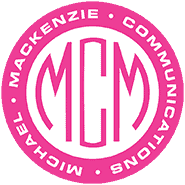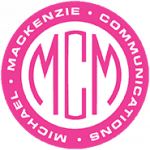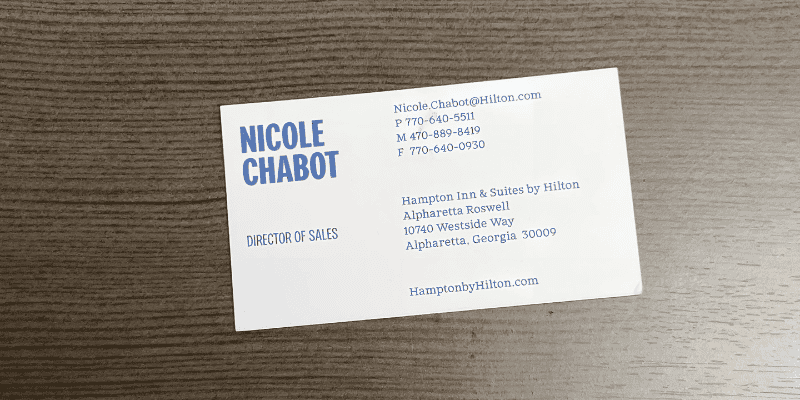Business cards rise and fall in popularity and in creative concepts.
Unless you are part of the small fraction of US workers who operate fully remote (just 12.2%), it is likely that you still go to an office, a client site or a professional function where physically sharing contact information with others is a requirement. And despite the ability to NameDrop with your iPhone, or employ other tap to share technologies, sometimes a business card is just really handy (and warranted).
As the entire purpose of a business card is to share contact information, obviously including your name, company name, phone and email are critical. But with each additional piece of information, some decisions have to be made.
1. Your Name. First Name and Last Name are a best practice (the exception being folks who are extremely recognizable but likely they don’t need a business card). Whether to include a middle name or initial is personal preference. Choosing to include a preferred name (like Bob, Rick or Andy) or nickname (like Tre or Sunny) instead of or in addition to your given name may be deemed appropriate and even helpful for some but just not necessary for others.
2. Any Credentials. Have an advanced degree or other earned or awarded credentials? Probably important to include those, too, especially if they are required to perform your role.
3. The Name (and Logo) of Your Firm. This may seem obvious but believe it or not, there are times when having the name of the company on your card is not automatic – like if you’re seeking a job or potentially trying to sell your company. In most cases, including the company name is a must-have and more often than not the inclusion of the brand elevates your standing (as well as that of your personal card if work for a trophy firm).
4. The Tagline. In addition to your company name, does your marketing department typically require that you also publish your tagline? If your business is not readily recognizable and the firm name does not communicate what you do, do you need to also include a tagline that explains it?
5. Your Contact Info. Are you an email person? Or do you prefer that people call you? Do you want to be called in your office or on your cell? Does your company provide you with a cell phone and if not, are you permitted to list your personal cell on your card? Does your company require all cards include the main phone line? Do you still have a fax machine and does it matter to anyone that you might meet? And if you answered yes to all of the above, do you even have room to list all of these numbers?
6. Your Job Title. Including your job title sounds like a no brainer, unless you change jobs often or hold multiple roles. It may not make sound financial sense to print multiple versions or make frequent changes. There are also just as many people who strive to achieve a C-level position and boast that on their card as there are C-level executives who chose to leave their title off their cards in order to avoid the annoyance of being targeted by salespeople and job seekers. There may be no more highly debated point than whether to include a job title.
7. A Business Address. Is having a brick-and-mortar business essential to operations? Do you want people to know where it is located? Will they visit your office to conduct business or simply want to know where to send packages? Do you have one address for billing and one shipping? Which address do you actually want to publish? And if there are multiple locations, how do you fit all of those on a card?
8. A Menu of Services. Just when you thought you had enough info crowded onto your card, there is a movement towards listing a menu of services on the card, in an effort to make service offerings even more clear.
9. A Coupon. A what? Yes, there are roles for which having a coupon on your business card makes loads of sense. Think: transactional items, frequent purchases and anything for which you might earn a commission and need to track leads back to the source.
10. A QR Code. I thought this was a fad that was apt to come and go but QR codes are back again and gaining popularity in a post COVID world as parties better understand how to use them to share and get information. Don’t want to print collateral to use as a leave behind for sales calls or distribute at events? Use a QR code.
11. Other Brand Logos. Work for a small company who resells products or services for a major brand? Probably going to want to include that logo on your card, too. But make sure you have permission AND you have the correct artwork in the right file format. Don’t just copy something online.
12. Associations and Memberships. Whether your firm is large or small, alignment with or membership in an association or honorary may not only set you apart but be a requirement to perform your job. Don’t be afraid to include that logo, font or approved text on your card if appropriate.
13. Your Photograph. Personally, I find this to be gauche but there is a time and a place for including a photograph on your business card, for instance if you are the brand, you’re selling yourself as a spokesperson, model or personality, or perhaps from a safety perspective to make sure that when the repairman arrives, they are who they say they are.
And if all of that isn’t enough to make your head spin, there are a multitude of graphic design and print production decisions to be made. Font, color and paper selection will convey a lot about your brand personality. Have too much content? Going to a 2-sided card works but eliminates the ability to use the backside for notes. Think those odd-size and shape cards look cool? Consider how or whether they fit in your wallet. Rounded corners? There is an upcharge. And most importantly – how does the card feel when you hand it over? Sometimes the paper stock and coating or other substrate chosen (like wood, plastic or metal) can make the difference as to whether and how much your card will stand out.
Finally, know that there is a business card etiquette observed when accepting a card Japan, requiring the recipient to accept the card with two hands, hold it no higher than chest high then take a slight bow as a sign of respect. We’d all like our cards to be handled that way. Make it count when deciding what you will and won’t include on your next card.
This blog was contributed by Jennifer Koon, Principal of Michael Mackenzie Communications.



